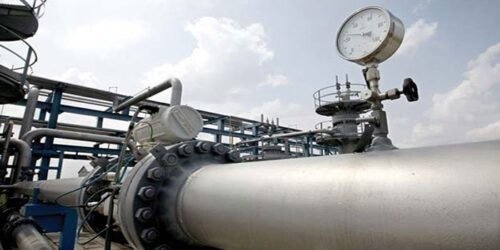In an alarming development, the local gas production in the country has tumbled by 10 per cent in 2019-20 to 2,138 BCFD (billion cubic feet gas per day) from 2.379 BCFD last year (2018-19) whereas the gas consumption has declined by 6 per cent to 3,714 MMCFD from 3,969 MMCFD during the same period.
According to the OGRA’s State of the Regulated Petroleum Industry Report for the fiscal year 2019-20, issued here on Wednesday, the natural gas production has gone down by 10 per cent in 2019-20. The deficit between production and consumption was partially met through RLNG import, whose share in natural gas supplies has increased from 27 per cent to 29 per cent during the current financial year.
The Oil & Gas Regulatory Authority (OGRA) presents its “State of the Regulated Petroleum Industry” report for the fiscal year 2019-20 in pursuance of Section 20 (1) (b) of the OGRA Ordinance, 2002.
The OGRA was established under the OGRA Ordinance in March 2002 with expressed objectives of fostering competition, increasing private investment and ownership in midstream and downstream petroleum sector and protecting public interest through effective and efficient regulation.
The refineries’ production has declined by 20.43 per cent to 9.86 million tons as compared to 12.38 million tons and consumption by 11.98 per cent to 17.63 million tons as compared to 20.03 million tons in FY 2018-19.
The report also says that the oil sector of Pakistan has faced major challenges due to the unprecedented crisis emanating from the COVID-19. Import of crude oil and petroleum products declined by 26.42 per cent and 7.60 per cent to 6.77 million tons and 8.10 million tons respectively during FY 2019-20 as compared to previous year’s imports of 9.21 million tons and 8.77 million tons.
It says PARCO holds its position at the top among all local refineries in production of petroleum products during FY 2019-20 with 29 per cent share (2.85 million tons) of total production, followed by BPPL with 22 per cent (2.13 million tons), ARL & NRL at 16 per cent (1.56 million tons) each and PRL with 12 per cent (1.21 million tons). The product-wise production shows that HSD had the highest share of 40 per cent (3.79 million tons) in total refineries’ production, followed by FO with over 23 per cent (2.22 million tons) and MS around 21 per cent (1.98 million tons) during FY 2019-20. These three POL products accounted for around 85 per cent (7.99 million tons) share in total refineries’ production.
The consumption of petroleum products in power sector suffered a huge decline of 43.5 per cent to 1.52 million tons during FY 2019-20 as compared to 2.76 million tons during FY 2018-19 due to the shifting of power generation from Furnace Oil to RLNG, followed by Government, where consumption declined by 10 per cent, transport by 5.6 per cent and industry 5.5 per cent. In the marketing arena, energy products have witnessed a change in the market share as compared to previous year.
PSO being the major shareholder with the highest market share, gained around 3 per cent (from 41 per cent to 44 per cent) during FY 2019-20, Hascol lost around 4 per cent market share from 10 to 6 per cent. Port handling facilities for petroleum products and crude oil in the country comprises of 03 Seaports, two in Karachi i.e., Keamari (KPT) and Port Qasim (PQA) with combined operational capacity of 33 million tons per annum and third is Single Point Mooring (SPM) with installed capacity of 12 million tons per annum owned and operated by Byco. Keamari is the largest among all operating with three oil piers having a combined installed capacity of 24 million tons per annum. Natural Gas Natural gas is a major contributing fuel in a country’s energy mix.
For the gas transportation and distribution the country has a huge transmission network of 13,452 Km and distribution network of 177,029 Km gas pipelines providing natural gas to domestic, industrial, commercial and transport sectors. The gas utility companies expanded their transmission and distribution network to cater the demand of its new consumers.
SNGPL and SSGCL have extended their transmission network by 190 Km and 72 Km respectively during FY 2019-20. Similarly, SNGPL extended its distribution network by 5,731 Km and SSGCL by 527 Km during the same period. SNGPL has connected 271,228 new consumers during FY 2019-20 reaching 7.0 million total consumers on its network. Whereas SSGCL has added 95,011 new connections making a total of 3.1 million consumers on its network.
Overall, there were10.12 million natural gas consumers in the country by the end of the financial year 2019-20. The main consumer of natural gas was power sector, consuming 33 per cent (1,198 MMCFD), followed by domestic sector with 24 per cent (888 MMCFD), fertilizer, 21 per cent (779 MMCFD), General Industry, 9 per cent (327 MMCFD) and captive power, 8 per cent (290 MMCFD) of the total gas consumed during FY 2019-20.
The province-wise gas consumption shows that Punjab’s share was 56 per cent (1,471 MMCFD), Sindh 33 per cent (874 MMCFD), KP, 9 per cent (249 MMCFD) and Balochistan, 2 per cent (48 MMCFD) of total gas consumption during the year under review.
Natural gas supply during the year was 4,052 MMCFD mainly contributed by the major gas fields such as Mari, Sui, Uch, Qadirpur, Kandhkot and Maramzai. Out of total supplies, 1,057 MMCFD of gas was supplied by the gas fields/producers directly to their consumers and the remaining through gas utility companies. Sindh’s share in gas supply was 45 per cent (1,344 MMCFD), whereas KP, Balochistan and Punjab supplied 12 per cent (368 MMCFD), 11 per cent (335 per cent) and 3 per cent (91 MMCFD) respectively.





